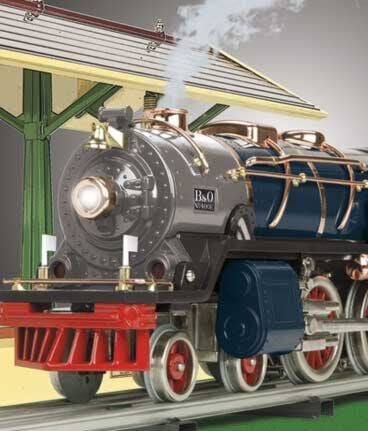
Used MTH 20-68228 Texas Special 70' ABS RPO Passenger Car (Smooth) w/Box
Used MTH 20-68228 Texas Special 70' ABS RPO Passenger Car (Smooth) w/Box
Exellent Condition
From a smoke-free home/collection
| Manufacturer | MTH |
|---|---|
| Scale | O Scale |
| MTH Style | Premier |
| Train Category | Passenger Cars, Premier Passenger, Premier Passenger Streamlined |
| Warning | Choking Hazard: Not for Children under 3 years of age |
Details
Used MTH 20-68228 Texas Special 70' ABS RPO Passenger Car (Smooth) w/Box
This O scale Rail Post Office car is in Excellent Condition from a smoke-free home/collection. There are no missing parts. There are minimal minute marks on the car. Two of the footstps are slightly bent inwards. The wheels show little to no wear. The lights and operating couplers function with no issues. This item is stored in its original packaging, which has a little wear.
See images for more!
Original Description:
The lightweight, streamlined passenger car was a product of the Great Depression. While the heavyweight steel cars built in the teens and 1920s were dependable and often luxurious, their dark colors and solid, battleship-like exteriors did little to lift the spirits at a time when the entire nation needed a pick-me-up.
As noted railroad historian John H. White, Jr. put it in The American Railroad Passenger Car, “Some hope during these gloomy years was offered by a new design concept called streamlining. It presented a sleek, modern image of speed and innovation. What had been an obscure technical term in aerodynamics was made into a household word through an astute publicity campaign mounted by several railroad traffic departments. It succeeded in creating a general interest in railroading practically unknown since the opening of the first transcontinental line… According to Railway Age, ‘For the first time in many years, the words ‘sold out’ re-entered the ticket clerk’s vocabulary.’”
But as White notes, the real change in passenger car construction was in weight, not the streamlined appearance that was largely for show: “Weight, not air friction, was the chief obstacle to economic operation.” Unlike the heavyweights, the lightweight cars that debuted in the mid-1930s featured sides and roofs that contributed to their structural strength, eliminating the need for the heavyweights’ massive underframes. Trucks went from six wheels to four, non-revenue space was decreased by using a vestibule on only one end of the car, and lighter, stronger, more rust resistant steel alloys came into widespread use. A typical new lightweight could be 15-20 tons lighter than the heavyweight car it replaced.
As with the diesel revolution that was simultaneously taking place, one of the key players in the changeover to lightweights was not an established industry name, but an upstart new player from the automotive industry: the Budd
Company of Philadelphia, a supplier of auto body stampings. In 1928, Edward G. Budd had heard about stainless steel, a lightweight, rustproof metal introduced in 1912 by Krupp of Germany. Budd was the first to grasp the potential of stainless beyond cutlery and novelty items. The key problem was the inability of stainless steel to be fabricated with normal welding techniques. Budd’s chief engineer, Colonel Earl J.W. Ragsdale, spent five years developing the key process needed to make stainless into a viable structural material: the patented Shotweld electric welding process.
Beginning with the Burlington’s Pioneer Zephyr of 1934, gleaming Budd-built trains, constructed almost entirely of stainless, helped define the look of the streamlined era to the American public — even on railroads like the Pennsylvania
and Norfolk and Western that painted over the stainless with company colors. While other car builders such as Pullman countered with stainless-sheathed steel cars like the Southern Pacific’s Daylights, they were forced to use rivets rather than welding for construction. In later years, the result was that Budd cars lasted almost indefinitely, while the stainless-sheathed imitators were plagued with out-of-sight rusting under the sheathing.
The majority of lightweights were 80’–85’ long, which scales out to about 21” in O gauge. Many O gauge modelers, however, find cars of this length impractical, as they require large curves and create long trains that can overwhelm a typical-sized layout. For those reasons, our Premier lightweights are about 70 scale feet in length — reproducing the look and feel of prototype streamliners in a model that will round O-42 curves with ease and look at home on most scale-detailed O gauge layouts.It is hard to match the excitement and beauty of a long, sleek passenger train speeding down the rails. M.T.H.'s Premier Line scale streamlined passenger cars and sets will bring exactly the right, realistic look to your passenger consists.
No other manufacturer matches the quality and value found inside an M.T.H. Premier Line passenger car. Using an intricately detailed, yet durable ABS body atop smooth rolling die-cast metal trucks results in a lightweight car that won't bog down a locomotive struggling to pull heavy aluminum passenger cars. What's more, each Premier Line passenger car features detailed car interiors and overhead lighting for a realistic and authentic appearance.
Features:
- Durable ABS Intricately Detailed Bodies
- Metal Wheels and Axles
- Overhead Interior Lighting
- Die-Cast 4-Wheel Trucks
- Operating Die-Cast Metal Couplers
- Colorful, Attractive Paint Schemes
- End-of-Car Diaphragms
- Fast-Angle Wheel Sets
- Needle-Point Axles
- Detailed Car Interiors
- 1:48 Scale Dimensions
- Detailed Car Undercarriage
- Separate Metal Handrails
- Unit Measures:19" x 2 7/16" x 3 1/2"
- Operates On O-42 Curves










